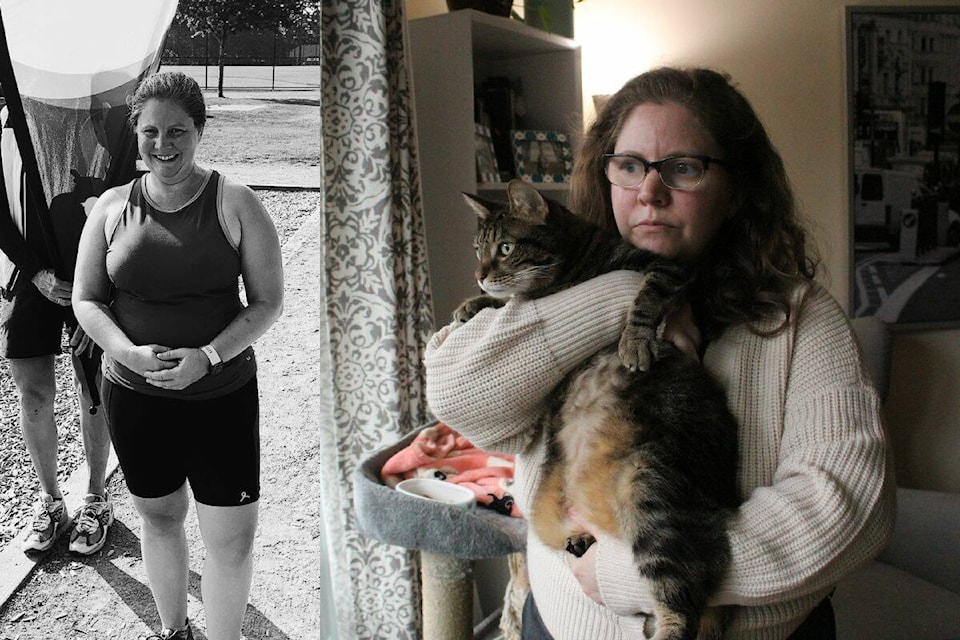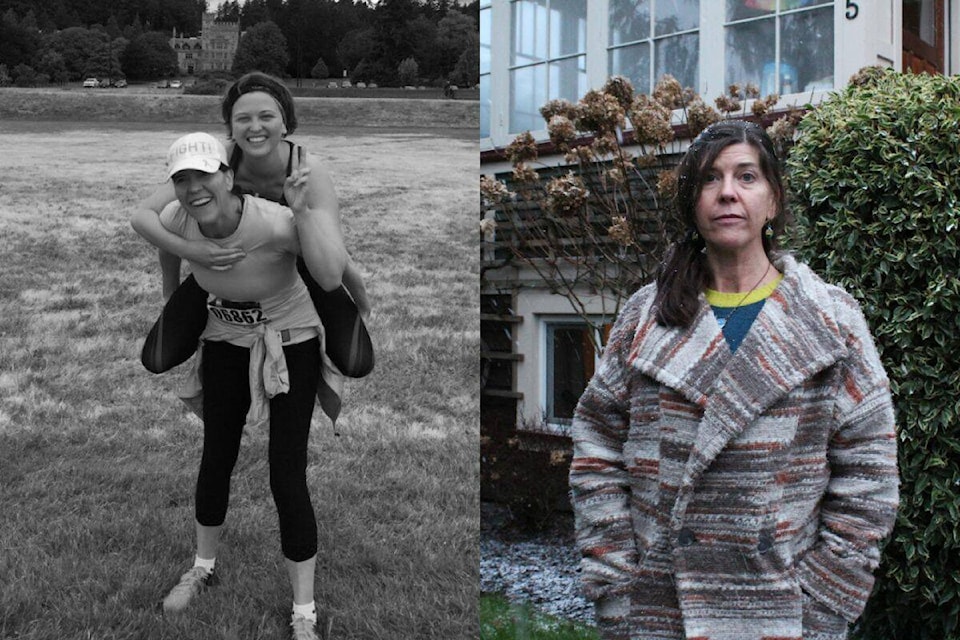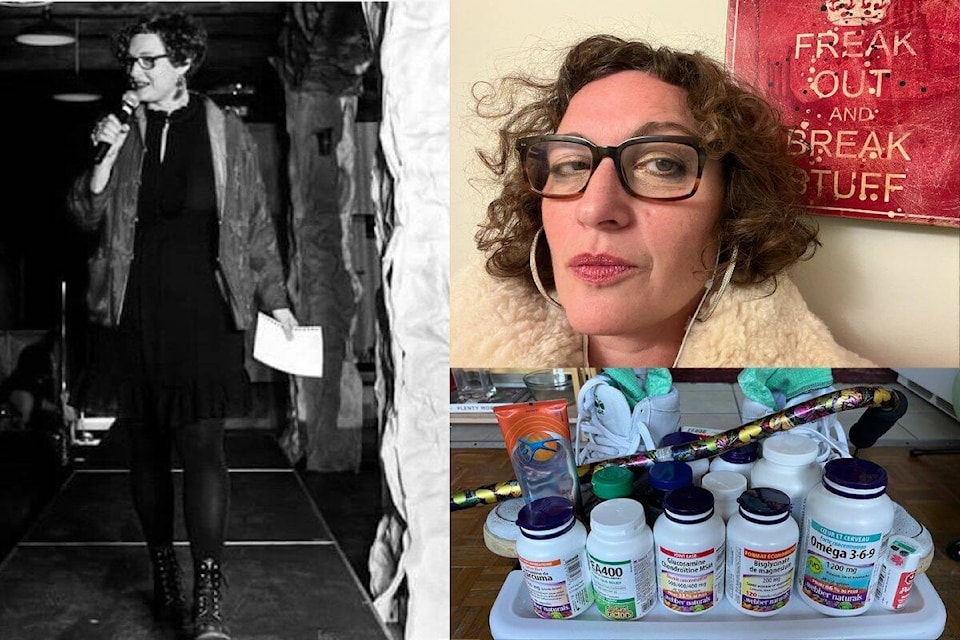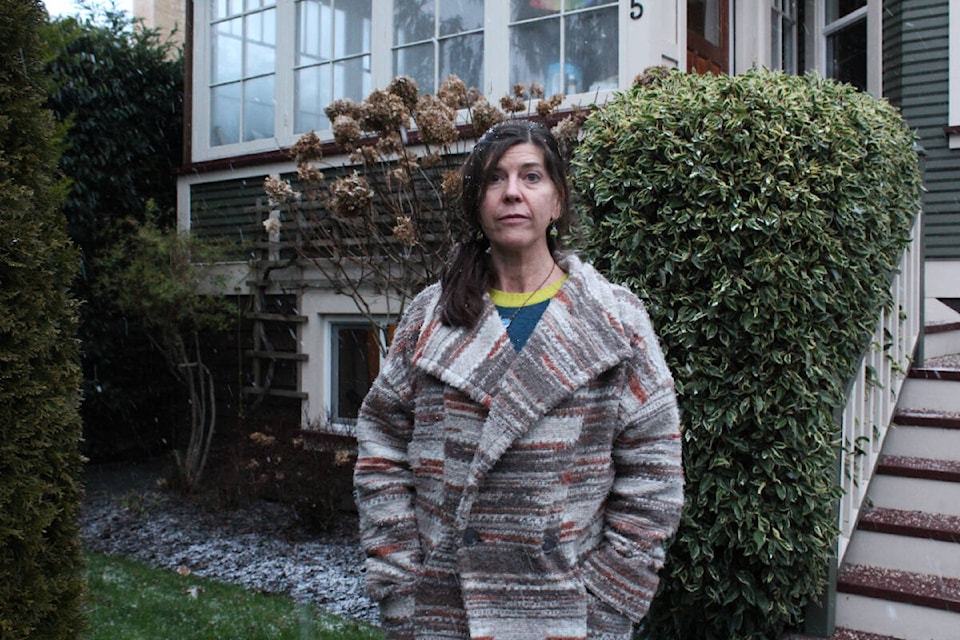Victoria resident Coreen Mason never thought COVID-19 would hit as hard as it did when she first caught the virus in September, let alone that she would be suffering devastating impacts months later.
“COVID-19 was always something that I took seriously but especially after having a few boosters …. I was convinced by the time I’d taken a few days off work, that I would be OK,” the 41-year-old said.
But a week after “horrendous lethargy,” some fever and a tiny bit of a dry cough, she woke up and “intense vomiting started.” After going through two IV fluid bags in 10 hours at the emergency, she was sent home.
Now, four months later, Mason is still severely impacted: suffering from constant exhaustion, brain fog and shortness of breath, among other symptoms. She is unable to do things that used to help her mental health, such as biking to work, joining her running group or going for long walks.
Add Mason to a list of Victoria residents suffering from long COVID or Post-COVID Conditions, broadly defined by the Centres for Disease Control and Prevention as signs, symptoms and conditions that develop or continue for at least four weeks after a COVID-19 infection.
Different organizations have different timelines. The World Health Organization defines it as three months after the original bout of illness or positive test result.

Long COVID is diverse and can include a host of strange symptoms including fatigue that interferes with daily life, blurred vision, persistent racing heart, flu-like symptoms, loss of smell and taste, brain fog and nerve pain. It can also include new-onset conditions such as diabetes, chronic fatigue syndrome (CFS) and more. These are just a few of the hundreds of symptoms recorded by patients. Based on a “conservative” estimate, a widely cited study found at least 65 million people around the world have long COVID.
While the cause is still not understood, pieces are slowly being put together.
READ MORE: ‘It’s really distressing’: Extensive long COVID symptoms linger, 2 years after infection
It’s not deconditioning: suffering from extreme fatigue
For Mason, the biggest struggle is with fatigue. A five-kilometre walk now feels more like a 10-km run.
She is frequently short of breath. If she increases her activity, she then endures severe fatigue and neurological symptoms like brain fog for several days. This is a phenomenon called Post Exertional Malaise (PEM), which the CDC describes as an onslaught of symptoms that can follow even minor activities. Symptoms typically worsen 12 to 48 hours after activity and last for days or even weeks.
This phenomenon is not actually new and is a hallmark of chronic fatigue syndrome (ME/CFS), a central nervous system disorder that commonly occurs in people following a viral infection.
Some studies estimate the number of people with long COVID that have chronic fatigue syndrome is around 50 per cent.
“I start feeling like I’m getting better and then I’ll end up doing a little bit too much and I’ll feel exhausted again,” Mason said.
New research is linking the fatigue to “clear changes” in the muscles of those with long COVID, according to a Dutch study published Jan. 4 in Nature Communications.
The study compared 25 patients who had long COVID to 21 healthy people who had fully recovered. The long COVID group had symptoms for at least six months and were all diagnosed with PEM.
Both groups worked out for 10 to 15 minutes on a stationary bike until they reached their maximum aerobic capacity. Thigh muscle biopsies were taken a week before they exercised, and a day after.
The findings were striking: Patients with long COVID displayed clear indications that the mitochondria, or energy factories of the muscle, functioned less well and produced less energy. The study noted “severe muscle tissue damage” with immense amounts of cell death.
It also found T-cells had infiltrated the muscles of long COVID patients. T-cells are a type of white blood cell that helps the immune system fight germs and protects the body from disease; they are very rarely found in healthy muscles. The tissue analysis possibly indicates “an autoimmune response within the muscle cells,” Akiko Iwasaki, a professor of immunobiology at Yale University, told NPR.
Rob Wüst, a study co-author, clarified on X (Twitter) that the findings were not a result of being out of shape after a period of resting from the virus.
“The cause of the fatigue is really biological,” Wüst said in an Amsterdam University Medical Centers (UMC) news release. “The brain needs energy to think. Muscles need energy to move. This discovery means we can now start to research an appropriate treatment for those with long COVID.”
The study has brought up strong emotions for many suffering, including relief.
“I cried when I read the article,” said Adriana Patino, director of Long COVID Canada.
Patino, who lives in Vancouver, was a competitive swimmer before she got COVID. She said she lost several relationships with friends and family members after months of fatigue, her heart rate randomly spiking and neurological issues.
“They didn’t believe me. They stopped talking to me, thinking I was victimizing myself, being weak, needing attention.”
It’s been a struggle for Patino, 39, to even do light workouts.
“As an athlete, I was always used to pushing through, keeping active. That landed me in the ER and I almost died.”
Living life as a ‘constrained self’
Before she got COVID, Victoria resident Jinelle Woodley, 56, was a full-time PhD student on leave as a nurse practitioner. She also ran a household, had three volunteer jobs and was physically active with marathon training five days a week, CrossFit three-to-four days a week and yoga three days a week. She was in Boston to run the Boston Marathon when she got COVID and her health completely deteriorated.

Woodley fell into the group of approximately one-third of people with long COVID who have no identified pre-existing conditions (an estimate published in Nature Reviews Microbiology).
“Long COVID rendered me largely bed-bound for the first four months,” she said.
Woodley said it was far beyond being unable to do any cognitive or physical work,. The “mildest of daily functions” that she had never before considered exertions now become intolerable.
“Things such as hearing a sound, looking at a screen, talking, moving from one room to the next, raising my arms, answering a question. On good days, I could muster some of these tasks, but over the next 48 hours my symptoms would worsen and remain flared for weeks.”
Woodley said she has “improved over time” with patience.
“I am now functionally independent, but am far from being able to work full-time or exercise.”
To avoid crashing, or Post Exertional Malaise, B.C.’s Post-COVID-19 Interdisciplinary Clinical Care Network recommends pacing, a method of finding one’s energy limit and working within it.
“Overexertion can lead to an unhelpful pattern where you ‘go until you can’t go any more’ and then ‘crash’ with worsened symptoms,” the clinic says in one of its worksheets.
Woodley describes this as living life as a “constrained self.”
Unfortunately the energy limit for many is extremely low and may be difficult to abide by given the demands of everyday life. Even after years, some patients, including some on disability, aren’t finding themselves back to normal.
It can affect anyone
According to the WHO, long COVID can affect anyone exposed to COVID-19, regardless of age or severity of original symptoms. Research is painting a clearer picture of who is most at risk.
A large analysis study published in JAMA Internal Medicine, which looked at 41 studies, found patients over 40, those with previous health issues, and those who had a severe COVID-19 infection had a greater risk. It also affirmed that vaccination lowers the risk.
Celebrities who have struggled with long COVID include Billie Eilish, Colin Farrel, Salma Hayek, Gwenyth Paltrow, Bethenny Frankel and Dave Navarro. NHL’s Brandon Sutter retired from the NHL in 2023 after two years of long COVID derailed his career.
Some studies estimate it’s likely about 10 to 30 per cent of people infected with COVID-19 will go on to develop long-term symptoms, though it is still unclear why. There are “likely multiple, potentially overlapping, causes,” said a widely-cited study published in Nature Reviews Microbiology.
In B.C., the Post-COVID-19 Interdisciplinary Clinical Care Network (PC-ICCN) has worked with 4,342 patients since its inception in May 2020.
READ MORE: Report says long COVID could impact economy and be ‘mass disabling event’ in Canada
Invisible illness
Many people living with long COVID report feeling isolated and without the support they need, due to it being an invisible illness not many people understand.
Riel Hahn, a former actress and artist who splits her time between Victoria and Vancouver, got COVID 15 months ago. She’s now on disability.
Hahn said she is extremely lucky to have a “really beautiful core group of friends,” who have stuck with her.
“I’m so grateful because I know there are lots of people whose doctors will still not acknowledge that something real is going on with them, and even if they do acknowledge, they don’t have the knowledge about it,” she said, speaking through tears.
Where she does struggle is managing living alone, and feeling misunderstood. A friend who saw her at an event said she seemed well and must be getting better.
“It made me feel like he doubted me. Like yeah, I stayed in bed for four days so I could go out for an hour.
“I don’t know why I look so good, my skin is glowing and I have good style right now,” she said with a laugh. “But I think I’m making an effort to do that because my insides feel like garbage. It doesn’t make me feel good to have messy hair and be in sweats all the time.”

Still, many of her symptoms go unseen to others. Hahn could be out for a walk with someone, and she’ll have to ask them to slow the pace.
“But what I’m not saying to them is all my joints are on fire while we’re walking and my right leg just stops working sometimes … and the insides of my muscles get this vibration, especially in my legs where they just start to internally shake, and I can just tell I’m so weak.”
Sometimes it feels like she can’t hold up the weight of her own head, with soreness above her ears and temples.
“It’s like my eyeballs start to shake and I can’t process visual information or sounds properly. I have to immediately get my head supported and if I don’t it’ll turn into a migraine very quickly and I’ll start to get very nauseous and very dizzy.
“People can’t see that those things are happening.”
Managing symptoms and uncertainty
For many who are diagnosed with long COVID, it’s a long game coloured by an endless navigation of doctor visits, disability forms, and redefining what their daily life and relationships can look like.
B.C.’s post-COVID care network said that the duration of symptoms varies, but approximately 35 to 40 per cent of patients show improvement after six to nine months.
B.C.’s post-COVID-19 Interdisciplinary Clinical Care Network said that 582 out of 3,526 respondents to a survey noted they were not able to work at all following their COVID-19 illness.
Those with the condition in B.C. continue to access resources like group education sessions, educational videos or written resource sheets through the care network. Patients can also be referred to an interdisciplinary team of allied health professionals, including physicians, physiotherapists, occupational therapists, nurses and social workers. Those in the clinic are treated with a focus on self-management of symptoms.
In many ways, B.C.’s PC-ICCN is a leader in long COVID care in Canada. The clinic said it is the first network of its kind in Canada to standardize post COVID-19 care across health authorities, add real-time research into clinical care, and provide online tools, including the MyGuide Long COVID tool.
The network has permanent funding from the B.C. Ministry of Health and promises to “continue to evolve” services in response to demand, patient needs and feedback.
It is also conducting a number of studies to understand the impact of long COVID on the employment and functioning of adults aged 18 to 64, including the long-term prognosis, the economic impacts, and the return-to-work experience.
Just like Woodley and Patino, Hahn said that over time she has learned to find where her energy-limit edges are and is managing her disability to the best of her ability. Symptom management for her includes seeing a counsellor regularly, watching her diet, taking a neuroplasticity course and lots of meditation.
“So much of it for me has to do with adapting and emotional resilience and acceptance,” she said. “And really, really soaking up the smallest glimmers of joy. Every small pleasure, every sunny moment, every bird, every minute I get to put my feet in the ocean.”
But for Hahn and many others managing this illness, they are uncertain what might come or if a treatment will ever become a reality.
“I just had the most big, colourful, beautiful, exciting, wonderful life and it’s a lot of grief for that and not understanding what future I can look at,” Hahn said.
READ MORE: Victoria post-COVID clinics close for in-person treatment, transition to virtual care
